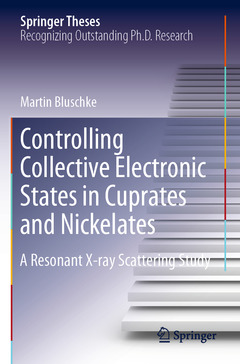Controlling Collective Electronic States in Cuprates and Nickelates, 1st ed. 2020 A Resonant X-ray Scattering Study Springer Theses Series
Auteur : Bluschke Martin

Nominated as an outstanding Ph.D. thesis by the Max-Planck-Institute for Solid State Research, Stuttgart, Germany
Provides an introduction to chemical and epitaxial methods for the manipulation of collective electronic ordering phenomena in strongly correlated quantum materials
Demonstrates a wide variety of resonant soft x-ray scattering and absorption techniques and their applications to model systems
Date de parution : 07-2021
Ouvrage de 151 p.
15.5x23.5 cm
Disponible chez l'éditeur (délai d'approvisionnement : 15 jours).
Prix indicatif 137,14 €
Ajouter au panierDate de parution : 07-2020
Ouvrage de 151 p.
15.5x23.5 cm
Disponible chez l'éditeur (délai d'approvisionnement : 15 jours).
Prix indicatif 137,14 €
Ajouter au panierThème de Controlling Collective Electronic States in Cuprates and... :
Mots-clés :
Controlling Collective States; Charge Density Wave in the Cuprates; Three-Dimensional Charge Density Wave Order in YBCO; Nickelate Based Heterostuctures; Artificial Antiferromagnetic Networks; Rare-earth Using Magnetic Anisotropy; Field Control of Antiferromagnetic Spin Orientation; Resonant X-Ray Scattering From Transition Metal Compounds
